
How Restaurant Lighting Can Transform Your Guest Experience
The right restaurant lighting can transform your space and your guest experience. Check out these tips to easily incorporate restaurant lighting design into your restaurant.

David GrayAuthor
When designing a restaurant, restaurant owners must balance their desire for a dynamic and unique space with their need for a functional space that works for their business.
One oft overlooked element of restaurant design is the power that the right restaurant lighting can have in shaping your restaurant’s desired look and feel. It's so important that 91% of casual dining patrons say ambiance plays a role in their dining choice; more then one in five diners name ambiance as their top factor for picking a restaurant.
We’re going to let you in on a little secret: Here are the five best restaurant lighting tips, tricks, and techniques from lighting professionals that will transform your guest experience.
Restaurant Floor Plan Templates
Use these restaurant floor plan templates to get inspired as you map, or reimagine, the layout and space setup for your restaurant.

1. It’s About Contrast, Not Brightness
The trick to functional restaurant lighting is not getting the room as bright as possible, but rather to balance the amount of light in an area with surfaces and colors that avoid glare and eye strain.
When our pupils are forced to adjust dramatically each time our eyes move from one surface to another, that’s a muscle being exerted. The result of more exertion is discomfort and headaches.
In a restaurant, the right amount of light for things like reading a menu or enjoying the appearance of a dish is:
- No more than three times as bright as the surrounding surfaces.
- No more than 10 times as bright as walls and floors within the line of sight.
When a room is brightly and evenly lit, this problem is avoided naturally; most fast food and lunch establishments don’t have much to worry about in this respect.
Stylized bars and dinner spaces are an entirely different story: Many establishments make the mistake of using one singular “dim” light over a table to illuminate the guest’s dining area, but the surface the light is meant to illuminate is completely black.
Since the small amount of light is being contrasted with very dark surrounding surfaces, it will appear very bright to guests' eyes. As a result, it becomes uncomfortable for the guest to look around the room and back to the group fairly quickly as their eyes can’t adjust; it’s likewise uncomfortable to look around the room and then try to read the menu.
This visual discomfort is due to the improper balance and contrast of light sources and the inability of the human eye to adjust quickly; it happens more often than we think. If your guests feel uncomfortable — visually or otherwise — when visiting your restaurant, they likely won't return a second time.
Help reduce the potential for your guests to experience visual discomfort by softly illuminating other areas, painting surfaces a lighter color to reflect more light, and keeping the sun shaded properly to prevent bright daylight from shining directly on the wrong areas.
2. Be Careful When Choosing LED
The advent of affordable, bright, LED light sources is here, and is projected to make up 60% of the world's lighting in 2020. Switching to or investing in LED light sources is a smart business decision: LED light sources pay for themselves with the amount of energy they save.
LED lighting is a better choice than standard incandescent and fluorescent lighting in nearly every situation unless you’ll be unwilling to part with the money necessary to replace your current restaurant lighting with LED alternatives.
This mainstream adoption of LED light sources, however, has brought with it several new and vitally important considerations for restaurant lighting.
LED technology is still largely under development and changes rapidly. Have you ever seen a repair shop that offers services for LED products? Not likely. Since LED technology and LED products change so frequently, it’s costly (read: a waste of time) for someone in repairs to constantly learn all the new features and the new challenges these features introduce.
Because there are no repair services, you need to consider what will happen if and when an LED lighting fixture fails, and how it could affect your business. While LED fixtures are supposed to last a long time, ask yourself:
- What is my plan should an LED fixture run out?
- Is it likely a replacement fixture will be readily available to match, or will I need to replace it with a different coordinating style?
- Am I financially able to replace all of my LED lighting fixtures so I can maintain a uniform look in my restaurant?
Given the constantly changing nature of LED technology, when you install a new bulb five years from now, it will likely be significantly brighter than the bulbs surrounding it, have a different Kelvin temperature, or have a different Color Rendition rating.
How can you manage against these future changes in LED lighting technology? Buy plenty of extra bulbs now so at least the color and initial brightness will be consistent when a bulb needs replaced.
The other option is to stay with incandescent bulbs and sockets and pay more for your electricity bill month-to-month instead.
3. Consider A 2-Circuit Track
The ability to adjust restaurant lighting around the room at a whim is appealing to restaurant owners and managers, which is why many restaurants invest in standard track lighting.
For those restaurateurs who want the adaptability standard track lighting systems offer, pause before you make the plunge and consider investing in a 2-circuit track.
Standard track and 2-circuit track systems look exactly the same and are installed no differently.
Though they’re slightly more expensive than standard track lighting systems, they make up for the cost difference in added benefits: A 2-circuit track provides restaurants with a second electrical load that can be controlled with separate switching, and even more lighting versatility than is possible with a standard track.
2-circuit tracks enable restaurants to "set the mood" and use one set of lights for daytime meal service, and a different set of lights for dinnertime.
If your intent is to have the most versatile and adaptable lighting for your space, upgrading to 2-circuit track is a moderate investment with considerable benefits.
4. Décor Can Affect Restaurant Lighting For Better Or For Worse
Lighting fixtures are not the only source of light in your space: Reflected and diffused light can be manipulated to provide comforting illumination in your restaurant.
Choosing lighter-colored paint, decor, and finishes for surfaces like countertops, tabletops, bars, floors, and walls will help reflect light within your restaurant and make it a more calm, welcoming, enjoyable environment for guests.
Your placemats, dish ware, tablecloths, and flooring also provide surfaces where light is reflected, diffused, or absorbed. A light-colored surface turns that surface into a light source; a dark colored surface will turn that surface “off” as a light source.
Beware: The choice of dark woods, darker menu paper, dark wall décor, and dark furniture as accents can absorb light and throw off your carefully created restaurant lighting balance.
In a dark-colored space, the proper way to light a room and avoid straining guests’ eyes is to provide less light and more surfaces to diffuse that light; indirect lighting becomes a near necessity to prevent glare in a dark space.
It’s also important to include non-glossy surfaces in your restaurant if you’re focusing on harnessing the power of reflected light. The glass over a picture, glossy paint, shiny metal furniture and chrome decorations can create annoying glare by reflecting too much light directly into the eyes of people.
Consider satin or matte finishes for materials that will have light shining directly onto them.
5. Control Stray Light
In any space, there are unavoidable sources of light that can undo all the careful time, effort, and attention you put into your restaurant lighting.
Light pollution can come from sources like unshaded windows on sunny days, bright kitchen lighting, hallways, landscape lights outside, and the reading light at a host stand.
Every time people look in the direction of a bright source of light, their eyes adjust; their eyes then need to adjust back when they turn their attention elsewhere. This adjustment can be uncomfortable and cause strain on the eyes.
How can you stop light pollution from negatively affecting your restaurant lighting? Here are a few suggestions:
- Window shades
- Choose a subdued, non-glossy paint for the kitchen walls visible to your diners
- Reposition outside lights shining on the building
- Adjust light shades on wall lights, overhead lights, and other lights in your restaurant so that the light bulb isn’t visible
- Relocate or shade any light bulbs you can see directly or in a reflection.
Tour your space frequently to have a handle on areas where a light source shines light improperly into the eyes of any customer.
Stray light can come from a variety of unplanned sources. Any step taken to minimize this will help increase the comfort of your establishment.
Let The Lights Dim Sum
There are a lot of restaurant lighting choices to make. Hopefully these five tips and tricks can help you provide a comfortable space to your customers with the illumination that helps create the experience that convinces them to return again and again!
Related Restaurant Resources
Is this article helpful?
DISCLAIMER: This information is provided for general informational purposes only, and publication does not constitute an endorsement. Toast does not warrant the accuracy or completeness of any information, text, graphics, links, or other items contained within this content. Toast does not guarantee you will achieve any specific results if you follow any advice herein. It may be advisable for you to consult with a professional such as a lawyer, accountant, or business advisor for advice specific to your situation.
Read More
Subscribe to On the Line
Sign up to get industry intel, advice, tools, and honest takes from real people tackling their restaurants’ greatest challenges.



